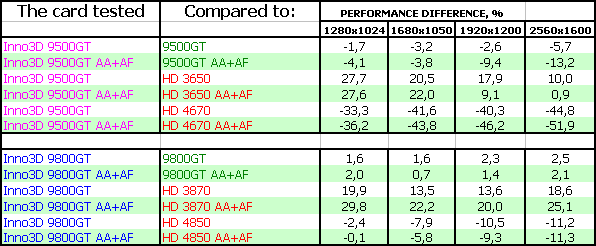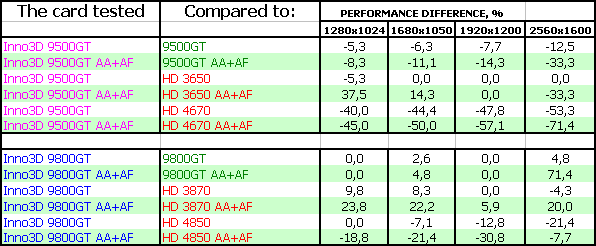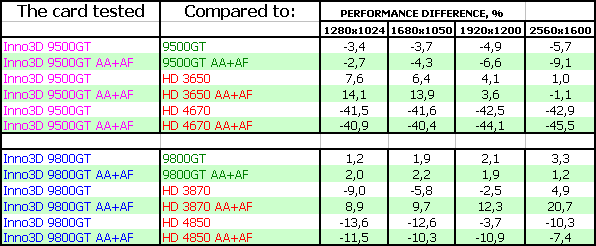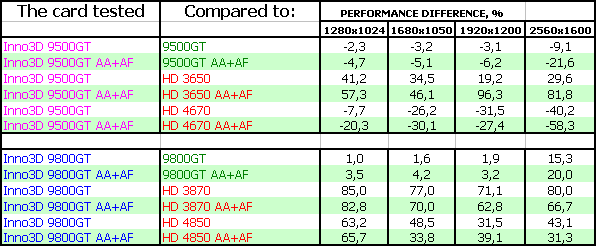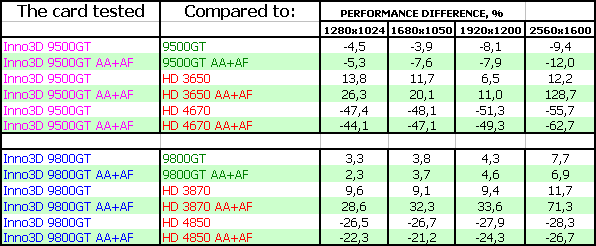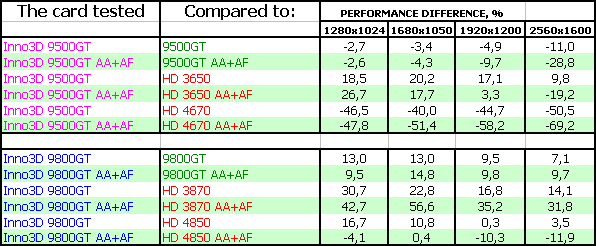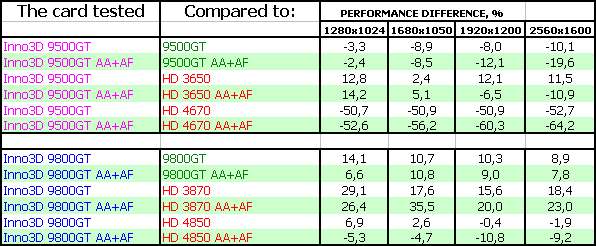Performance tests
Testbed
- Intel Core2 Extreme QX9650 (3000 MHz) CPU
- Zotac 790i Ultra motherboard on NVIDIA nForce 790i Ultra
- 2GB DDR3 SDRAM Corsair 2000MHz
- WD Caviar SE WD1600JD 160GB SATA hard drive
- Tagan TG900-BZ 900W PSU
- Windows Vista 32bit SP1, DirectX 10.1
- Dell 3007WFP 30-inch monitor
- ATI CATALYST 8.8; NVIDIA 177.79
- VSync disabled
Benchmarks
- Call Of Juarez (Techland/Ubisoft) -- DirectX 9.0, Shaders 3.0 (HDR), maximum quality settings; demo, batch file included.
- S.T.A.L.K.E.R. 1.003 (GSC Game World/THQ) -- DirectX 9.0, maximum quality settings (dynamic lighting enabled); demo, copy files to the savegames folder, run the game, load level 'ixbt3', and type "demo_play ixbt3" in the console.
- 3DMark Vantage 1.00 (FutureMark) -- DirectX 10.0, Shaders 4.0, multitexturing, 'Extreme' settings.
- CRYSIS 1.2 (Crytek/EA), DirectX 10.0, Shaders 4.0, 'Very High' settings, levels 'Rescue' and 'Harbor'; batch file, e-mail us to obtain the timedemo. We express gratitude to CRYTEK for creating a timedemo for iXBT.com / Digit-Life.
- Company Of Heroes Opposing Fronts (Relic Entertainment/THQ) -- DirectX 10.0, Shaders 4.0, maximum quality settings; batch file, run the game, invoke graphics settings and click the test button.
- World In Conflict 1.007 (Massive Entertainment/Sierra) -- DirectX 10.0, Shaders 4.0, 'Very High' settings with adjusted AA and AF; run the game, invoke graphics settings and click the test button.
- Devil May Cry 4 (CAPCOM) -- DirectX 10.0, 'Super High' settings with adjusted AA and AF; Scene 1 and Scene 4.
S.T.A.L.K.E.R.
Performance charts: S.T.A.L.K.E.R.
World In Conflict
Performance charts: World In Conflict
Call Of Juarez
Performance charts: CoJ
Company Of Heroes
Performance charts: CoH
3DMark Vantage, Graphics MARKS
Performance charts: 3DMark Vantage, Graphics MARKS
Devil May Cry 4, SCENE1
Performance charts: Devil May Cry 4, SCENE1
Devil May Cry 4, SCENE4
Performance charts: Devil May Cry 4, SCENE4
Conclusions
Inno3D GeForce 9800 GT 1024MB is an interesting product as far as its memory volume is concerned. But our tests prove that it does not yield great advantages. Such memory volumes are necessary for powerful Hi-End products, not Mid-End solutions. In other respects, the card failed to produce a distinct positive impression. Poor bundle, no temperature monitoring, usual cooler. It will all depend on the price tag. If it's attractive, and you don't care about the bundle, this card will find its user. I repeat, there is no reason to install so much memory on such graphics cards, except for a number of games in high resolutions.
Inno3D GeForce 9500 GT 512MB is nothing special. Low frequencies, lower than NVIDIA recommends, even though manufacturers usually try to raise them. One DVI jack is stripped down to Single-Link, poor bundle. However, don't forget about the price factor. It's probably the most important criterion for graphics cards of this class. But in our opinion, you'd better pay attention to faster solutions, even if they are a tad more expensive.
Unfortunately, we must admit that these graphics cards from InnoVision are no jewels, even the large memory volume is of little help here. They might have at least raised operating frequencies or something. However, we should note the good quality of both products, no gripes with that.
Afterword
A few words about our benchmarks.
In our updated FRAPS review we have illustrated how crude and inaccurate tests with this utility are. Testers do not have other tools, except for benchmarks built into games.
This article and its first part explain that it's sometimes possible to test games with integrated and identically looped demos. Although this implies lots of potential errors, since measurement accuracy depends on a given tester: whether he starts/stops FRAPS in time or does it too late/early.
But I have run across situations, when demo load changes abruptly in the very beginning or end. So a half-second delay in starting/stopping the utility changes the average FPS by 15-20%. That's not a measurement error anymore - such a test is a total waste of time. One time you delay the test, another time you start it too early (not intentionally, of course), and you end up with absolutely different performance results.
But even that's not the most important thing. The fact is, there are almost no games with built-in demos anymore. So, testers are forced to use a method that we deem totally unacceptable. They measure gaming performance by walking a straight line from the a starting point in a scene to a selected destination (the nearest fence, tree, etc.).
We all understand that it's impossible to navigate to a finish spot in precisely the same route with different cards and in different resolutions. Besides, such games always introduce random elements into a scene, and objects may be placed slightly differently on the same scene.
Unfortunately, websites that publish a huge number of tests do not always reveal their test methods for each game (except for those with built-in benchmarks).
So, we believe that it's better to offer a limited number of game tests, but each will be crystal clear, accurate and showing actual differences between graphics cards.
Write a comment below. No registration needed!

